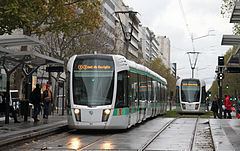Rolling stock Alstom Citadis | Line length 22.4 km (13.9 mi) | |
 | ||
Ridership 30,000,000 riders/year (approx.) Opened 2006 (2006)
(last extension in 2012) Track gauge 1,435 mm (4 ft 8 ⁄2 in) | ||
T3 tram in paris france le de france tramway line 3
Tramway line T3 is the first modern tramway in Paris proper, since the 1937 closure of the previous comparable system. It is operated by the Parisian Transport Authority (RATP: Régie autonome des transports parisiens), and is divided into two sections called T3a and T3b. The line is also known as the tramway des Maréchaux because it follows the boulevards des maréchaux, a series of boulevards that encircle Paris along the route of the former Thiers Wall (built 1841–44). The boulevards are, with three exceptions, named for Napoleon's First Empire marshals (maréchaux), and were transformed by redevelopment works carried out during the two and a half year construction of the line, which opened on 16 December 2006 under the designation T3.
Contents
- T3 tram in paris france le de france tramway line 3
- Timeline
- Little Ring Line
- T3a
- T3b
- Rolling stock
- References
The line runs in its own section of the roadway of these boulevards between the 15th and 13th arrondissements of Paris, allowing it to connect Pont de Garigliano and Porte d'Ivry in an average of 26 minutes. It carried 25 million passengers in its first year of operation, averaging 100 000 every weekday, and 70 000 at the weekends; numbers have steadily increased ever since.
In 2009, further work began to extend the line to the east and north, with the extension fully opening on 15 December 2012. Two separate lines were constructed to ensure the service's reliability: the existing line was extended to Porte de Vincennes and renamed T3a; a second line (T3b) connects Porte de Vincennes to Porte de la Chapelle. Currently, a possible extension of this new line to Porte d'Asnières by 2017 is under consideration.
Timeline
Little Ring Line
The Little Ring Line (Ligne de Petite Ceinture) was constructed in order to link the major rail supply routes within the Thiers Fortifications that surrounded Paris. The line was opened in sections between 1852 and 1869, reaching a total length of 32 km and encircling Paris within the boulevards des Maréchaux.
Initially, the line was for the exclusive use of freight traffic, before subsequently opening to passenger traffic. The ligne d'Auteuil, in contrast, opened to passengers only immediately in 1854, and only opened to freight in 1867. The railway saw a rapid growth in passenger numbers towards the end of the 19th century, especially during the Universal Expositions. However, the inappropriateness of the equipment, consisting of steam locomotives that made the cars hot and uncomfortable, made the line less and less attractive, and it was unable to resist competition from the Métro.
After 1900, passenger numbers saw a constant and relentless fall until, in April 1934, despite several failed attempts to improve the situation, the line permanently closed to passengers, except the ligne d'Auteuil, which remained open until January 1985. Some months later, in July 1934, the PC Bus Line was created, and was an immediate success.
Freight traffic also disappeared at the start of the 1990s, and most of the line has since been abandoned and split by modern development. The section of the ligne d'Auteuil between Pereire-Levallois and Avenue Henri-Martin, however, was integrated with Line C of the Regional Express Rail Network of Paris (RER: Réseau express régional d'Île-de-France).
T3a
T3a connects Boulevard Victor – Pont du Garigliano RER station in the western part of the 15th arrondissement with Porte de Vincennes metro station in the 12th arrondissement. The line carries 112,000 people per day.
The first section, between Pont du Garigliano and Porte d'Ivry, opened as T3 on 16 December 2006. Work began in early 2009 on a 14.5 kilometres (9.0 mi) extension from Porte d’Ivry to Porte de la Chapelle, via Porte de Charenton. The extension project was then split into a smaller extension to Porte de Vincennes and a separate tramway line for the remainder of the route, which became T3b. The opening of the extension and renaming to T3a occurred on 15 December 2012.
T3b
T3b connects Porte de Vincennes with Porte de la Chapelle in the 18th arrondissement. It opened concurrently with the extension of T3a to Porte de Vincennes on 15 December 2012.
Rolling stock
The design selected for line T3 was the Alstom Citadis 402.
The trains were ordered in December 2003, and manufactured in factories at Le Creusot (bogies), Tarbes (electrical and electronic traction), Villeurbanne (electronics), Ornans (motors), with final assembly performed at Aytré, near La Rochelle.
Their design aesthetic was the subject of extensive research by several designers: Régine Charvet-Pello (and designers of his company RCP Design Global) for the general concept, the colorist for Vonnik Hertig upholstery and indoor environment, Emmanuel Fedon and Luc Maillet for exterior trains. The livery of trains is personalized, combining RATP's traditional jade green with various visual symbols of the city.
